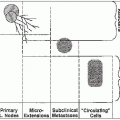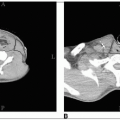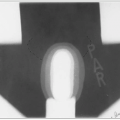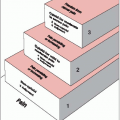Lymphomas constitute the third most common childhood cancer.
Pediatric Hodgkin’s disease (HD, Hodgkin’s lymphoma) is more common than non-Hodgkin’s lymphoma (NHL).
There is a bimodal age distribution. The childhood form occurs in patients aged 14 years or younger and is rare in children less than 4 years of age. The young adult form affects people aged 15 to 34.
There is a strong association between HD and the Epstein-Barr virus (EBV). EBV-positive tumor genomes are more frequent in children younger than 10 years of age who live in developing countries (1).
The Rye classification is discussed in Chapter 40.
Nodular sclerosing HD is the most common subtype in all age groups; it is more frequent in adolescents (77%) and adults (72%) than in younger children (44%) (4).
In an analysis of 2,238 patients, lymphocyte predominant HD was relatively more common (13%) in younger children (age less than 10 years), whereas lymphocyte depleted HD was exceedingly rare (4).
Mixed cellularity HD is more common in younger children (33%) than in adolescents or adults (11% to 17%) (4).
Most children (80%) present with cervical lymphadenopathy
Mediastinal involvement is present in approximately 75% of adolescents, but in only 33% of children 1 to 10 years old.
One third of patients have one or more “B” symptoms at diagnosis (unexplained fever of more than 38°C and recurrent during the previous month, night sweats during the previous month, or weight loss of greater than 10% in the 6 months preceding diagnosis) (7).
The diagnosis of HD is made by lymph node biopsy and confirmed pathologically by the presence of Reed-Sternberg cells and mononuclear variants.
Recommended procedures for pretreatment evaluation in the child with HD are similar to those for the adult.
As with adults, children with HD are staged according to the system devised at the Ann Arbor Staging Conference in 1970. See Chapter 40 for complete staging.
The distribution of stages observed in children is different from that in adults. Among 2,238 patients treated consecutively at Stanford University, stage I or stage II disease was present in 60%. Stage I was slightly more common in younger children (18%) than in adolescents (8%); stage II disease was seen in 40% to 50% of all age groups; stage IV disease was observed in younger children (3%) less often than in adolescents (15%) (4).
Several factors influence the choice and success of therapy; stage, bulk, and biologic aggressiveness are frequently codependent.
Stage of disease is the most significant prognosticator of treatment outcome.
Bulk of disease is reflected in the disease stage. Large mediastinal adenopathy (more than one third of the maximum transthoracic diameter) and multiple sites of involvement (most often defined as more than three) with extensive splenic disease (more than four nodules) are associated with increased risk of recurrence after irradiation alone (27).
Stage IV disease has exceptionally poor prognosis when managed with conventional therapeutic techniques.
Systemic symptoms (B disease) correlate with an increased risk of relapse (7).
Adverse prognostic factors include stage IIB, IIIB, and IV; B symptoms; bulky disease; male gender; WBC count greater than 11,500/mm3; and hemoglobin ≤11 g per dL.
Lymphocyte-depleted histology confers a worse outcome than other subtypes (27).
Mixed cellularity disease is associated with an increased risk of subdiaphragmatic relapse in pathologically staged patients who have disease apparently confined to supradiaphragmatic areas.
Children 10 years of age or younger fare better than older patients (4).
Although the biology and natural history of HD in children are similar to those in adults, substantial morbidity (particularly musculoskeletal growth inhibition) occurred when irradiation techniques and doses used in adults were administered to children.
To decrease the morbidity from radiation therapy, investigators at Stanford pioneered the use of multiagent chemotherapy in combination with lower doses of irradiation for young children with both early- and advanced-stage diseases. This combined-modality approach has resulted in excellent local control rates (8).
Low-dose (15.0 to 25.5 Gy) involved-field radiation remains a critical component of combined-modality treatment.
Involved-field radiation therapy (IFRT) guidelines are outlined in Table 49-1.
The combination of doxorubicin (Adriamycin), bleomycin sulfate, vinblastine sulfate, and dacarbazine (ABVD)—which has been extensively tested as a substitute for mechlorethamine hydrochloride, vincristine sulfate (Oncovin), procarbazine hydrochloride, and prednisone (MOPP)—successfully decreases the risk of sterility and second malignancies (9).
Since the initial use of MOPP in the 1960s, marked improvement in cure rates has been achieved in the management of pediatric HD.
Subsequent therapies have built upon the MOPP backbone. ABVD was developed as an alternative effective regimen in an attempt to improve survival and decrease long-term effects of treatment such as sterility and second malignancy (13).
In a randomized study of children with stage III to IV HD, the Children’s Cancer Group reported a 4-year disease-free survival rate of 87% in 57 patients treated with ABVD and lowdose extended-field irradiation versus 77% in 54 patients treated with MOPP/ABVD (13).
Despite excellent tumor control with ABVD, bleomycin sulfate and doxorubicin cause pulmonary and cardiovascular damage (respectively), the intensity of which may be exacerbated by the addition of mediastinal or mantle irradiation (17, 28). In an attempt to decrease alkylator therapy and potential cardiotoxicity, the Pediatric Oncology Group (POG) developed a series of studies built upon the ABVD backbone, substituting dacarbazine with etoposide.
The German cooperative groups have built upon cyclophosphamide, vincristine, prednisone, and procarbazine (COPP) chemotherapy in both pediatric and adult HD. The DAL-HD-90 study uses OEPA/COPP for males and OPPA/COPP for females, both followed by IFRT (24).
TABLE 49-1 Involved Field Radiation Guidelines | ||||||||||||||||
|---|---|---|---|---|---|---|---|---|---|---|---|---|---|---|---|---|
| ||||||||||||||||
The use of radiation therapy in isolation has largely been abandoned. A possible exception is the fully grown child with localized nodular lymphocyte predominant HD.
Single-modality chemotherapy treatment usually involves more cycles of chemotherapy, whereas combined-modality therapies prescribe low-dose, involved-field radiation in lieu of several chemotherapy cycles.
Chemotherapy alone offers the advantage of eliminating the potential toxicities of irradiation; disadvantages include the toxicities associated with intensive drug therapy and the increased likelihood of disease recurrence in sites of bulky disease without use of radiotherapy (6, 12).
Earlier randomized pediatric trials prospectively comparing outcomes in patients treated with chemotherapy alone to those treated with combined-modality therapy have not definitively established the superiority of one treatment approach over the other (13, 29).
Children’s Cancer Group investigators compared COPP/ABV hybrid chemotherapy and low-dose, involved-field radiation to treatment with COPP/ABV chemotherapy alone. Significantly higher 3-year event-free survival was seen in patients randomized to receive combined-modality therapy. Early follow-up did not demonstrate a significant difference in overall survival among the groups due to the successful salvaging of relapsed patients (21).
The Children’s Oncology Group (COG) is now examining whether risk-adapted therapy can identify patients who require radiation and those who can be cured by limited chemotherapy alone.
Stay updated, free articles. Join our Telegram channel

Full access? Get Clinical Tree








